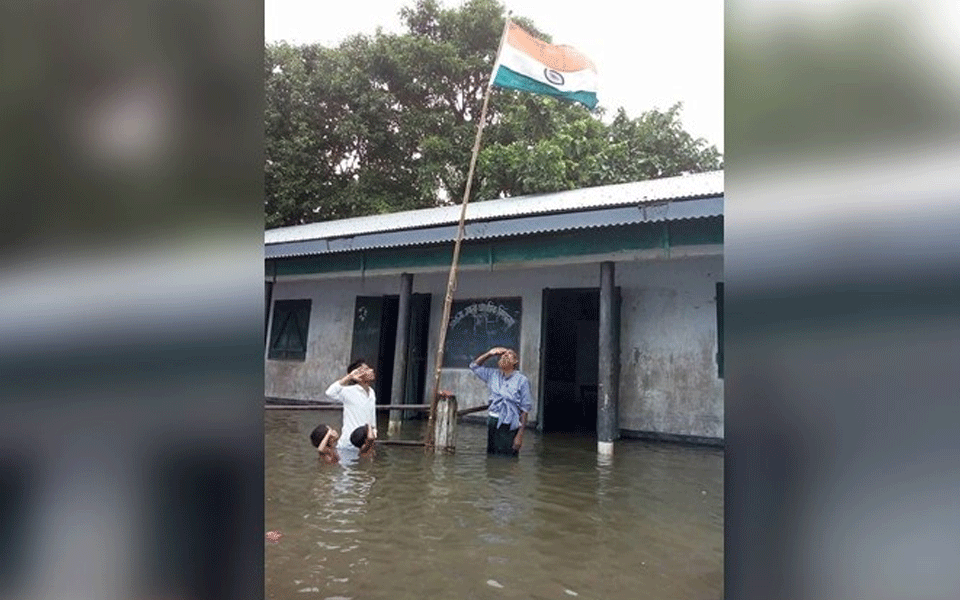Assam, August 15: IT WAS a photo that warmed the heart of a nation last Independence Day. Two children, standing chest-deep in flood water at their lower primary school in Assam’s Dhubri district, looking up to salute the Tricolour. There were two others in the frame, their teachers.
Today, the image has returned to haunt one of them. Nine-year-old Haydor Khan, on the left, has not found a place in the final draft of the National Register of Citizens (NRC).
The rest have made it: Haydor’s 10-year-old relative Jiarul Khan, the other child in the photo; head teacher Tazen Sikder, in the blue shirt; and, assistant teacher Nripen Rabha.
Everyone else in Haydor’s family have got in, too: Joygon Khatun, his mother who works as a domestic help; his 12-year-old brother and six-year-old sister; and, even his grandfather Alom Khan. Haydor’s father, Rupnal Khan, was killed in a clash in Kokrajhar in 2011.
This Independence Day, Haydor’s voice betrays the tension within. “I don’t understand anything about the NRC… I will do whatever the learned people in our area say,” he says, speaking to The Indian Express over phone from his home in Barkalia-Naskara village.
But ask him about that photo, taken amidst the August floods in Assam, and he opens up.
“Everything was under water. The other children were scared to swim to the point where the national flag was being hoisted in our school. But Jiarul and I swam up to the spot, stood there and saluted our flag,” says Haydor, a Class 4 student.
The photo was first uploaded by Mizanur Rahman, another teacher at the No. 1185 Naskara lower primary school. It went viral.
“We had decided that a few teachers would hoist the flag, since it was very risky for the children to make their way through. But once the flag was raised, Jiarul and Haydor removed their shirts and jumped into the water to come and salute the flag. Such was their eagerness to show respect towards the national flag,” says Sikder, the head teacher.
But now, all that Haydor’s mother and the rest of his village want is for him to be declared an Indian citizen in the NRC.
”People of our community are often rebuked as Bangladeshis but we are genuine, patriotic Indians. We are hopeful that Haydor’s name will appear in the final NRC,” says Kolimuddin Mondol, a neighbour who teaches at a local college.
According to Haydor’s family, his mother has submitted a form at the local NRC seva kendra to know the reason for his exclusion. The standard operating procedure and modalities of the claims round is expected to be clear after a Supreme Court hearing on August 16 — the central government filed the proposed SOP for consideration in the court Tuesday.
Haydor is among the over 40 lakh people excluded from the final draft published last month. The extended family draws its legacy from Sukur Ali, the great grandfather of Haydor, who was in the 1951 NRC and had land records preceding that, says Amir Ali Khan, the brother of the boy’s grandfather.
The NRC is being updated to include the names of those persons or their descendants who appear in the 1951 NRC or in any of the electoral rolls or in any one of the other admissible documents issued upto the midnight of March 24, 1971, to identify illegal migrants.
Haydor’s relatives say they are “struggling to make ends meet”, especially after the death of his father, a scrap collector, in the clash that they allege was a case of ethnic violence involving Bodos.
“Now, we are scared that the exclusion of Haydor’s name will make our lives more difficult,” says Khan, a marginal farmer.
Courtesy: indianexpress.com
Let the Truth be known. If you read VB and like VB, please be a VB Supporter and Help us deliver the Truth to one and all.
Bengaluru: Karnataka’s district judiciary is facing a significant shortage of judicial officers, with approximately 27.5% of positions across the state's district courts remaining vacant.
According to data cited by The Times of India on Tuesday, out of a total of 21,541 positions, 5,926 remain unfilled, leading to concerns about the efficiency of the state's justice system.
Bengaluru city is particularly affected, with 835 vacancies out of 2,510 sanctioned posts. Bengaluru Rural courts follow closely with 532 vacant positions from a total of 1,003 sanctioned roles. Mandya district shows an alarming vacancy rate, with 376 vacancies against 844 sanctioned positions.
Several other major districts are also grappling with alarming staffing deficits, including Mysuru (299 vacancies) Belagavi (345), Tumakuru (279), Dakshina Kannada (312), and Hassan (207).
Apart from vacancies of judicial officers, 243 of the 1,395 sanctioned posts for district judge, ad-hoc district judge, senior civil judge and civil judge remain vacant, the report added.
Legal experts have stressed that addressing the judicial vacancy crisis should be a priority for the state government to ensure the effective functioning of the justice delivery system. These staffing shortages may contribute significantly to case backlogs and undermine public confidence in the judiciary.
Meanwhile, Minister for Law and Parliamentary Affairs M.B. Patil, recently stated in the legislative assembly that efforts to fill the vacancies are underway. He cited a notification from February 2025, which will see 158 civil judge positions filled in the near future.


_vb_55.jpeg)
